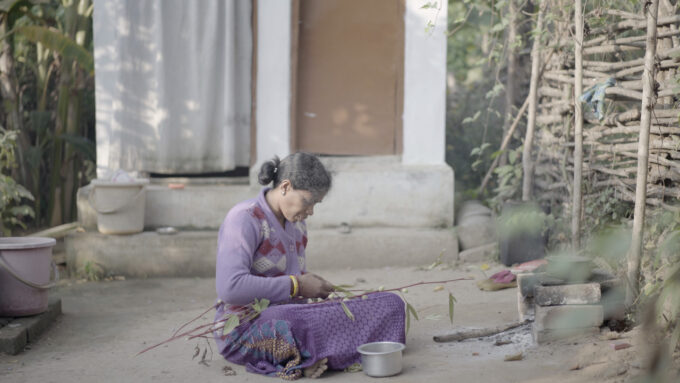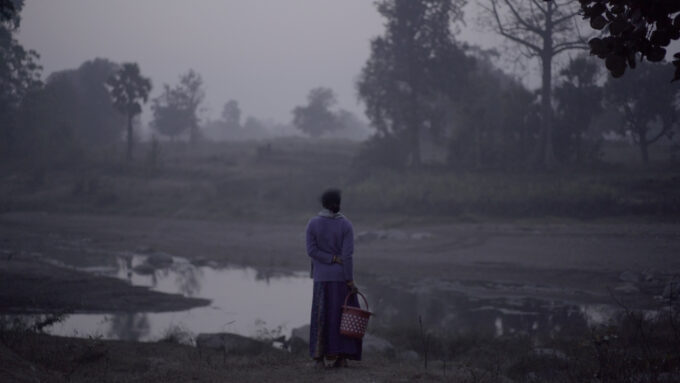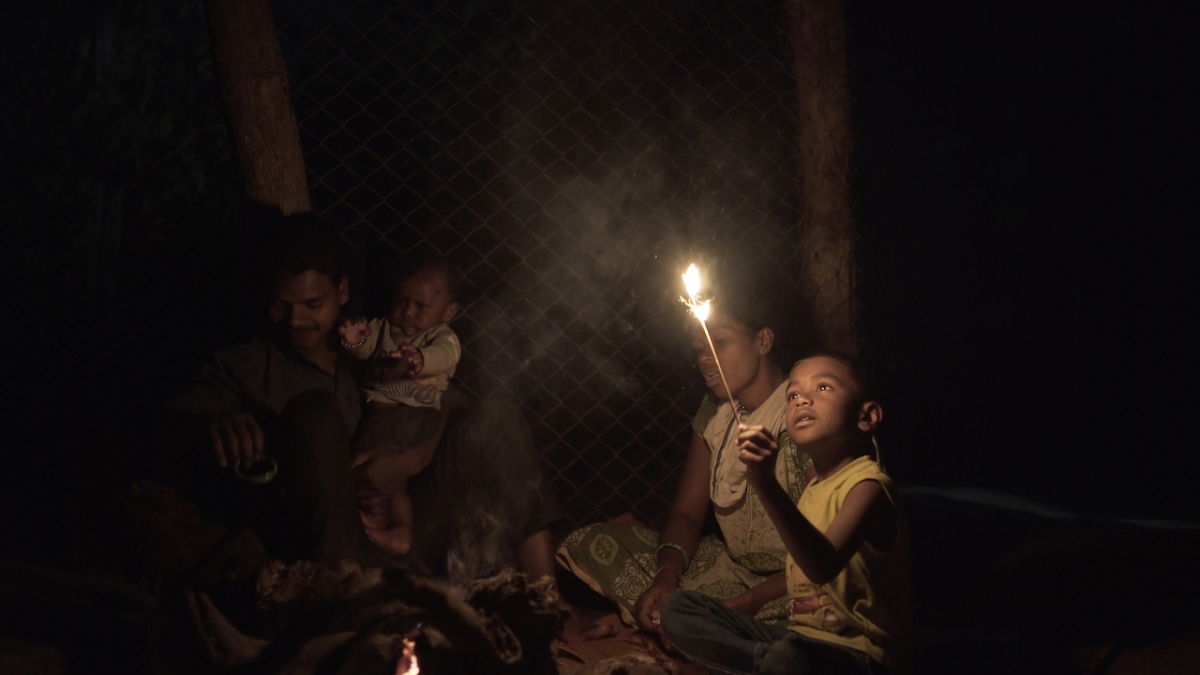Written By: Kano Umezaki
This article may contain spoilers.
At night, around the time the moon’s gaze is at its highest, three people sit around a fire. “Today was supposed to be my funeral,” one man says. Laughter follows, along with the dissipated sound of fire crackling. As the audience, we sit patiently, listening as the storytelling begins.
Much of the NoCut Film Collective’s debut feature film, “A Rifle and a Bag,” unfolds like this, with people passing down stories of their past. They tell each other about their time as former Naxalites –– a revolutionary Maoist organization primarily mobilized by India’s most vulnerable populations –– where they organized against landlords, cops and other agents of the state. “We were immediately intrigued by the ambiguous position of these fighters who participated actively in the guerrilla but eventually decided to desert it,” shares the NoCut Film Collective. “Their particular point of view, their struggle to position themselves in between the guerrilla and the civil society, was something that we really wanted to explore.”
The Indian government has branded Naxalites as threats to internal security, as dangerous extremists in need of extinguishing. But the stories circulated in the film show people who fall otherwise. For Somi in particular, an ex-Naxalite woman with a heart of strength, we see how her time as a guerrilla fighter stemmed from care, as well as bare necessity. While she speaks to her son near a riverbed in the film, she explains: “The landless should get land. The homeless should get homes. The poor should be governing the country. They need democracy. To make it happen, your father and I went there with a gun.”
When we first see Somi and her husband, Sukhram, their faces are introduced as strangers. The film speaks to us with people and frames that bear no introduction. As narration takes a backseat, our eyes fall quietly onto a story we slowly begin discovering. We soon see the patriarchal overtones of India’s caste society, which deem Somi’s caste certificate as inferior to her husbands. When trying to enroll her son into boarding school, we see her struggle because although Sukhram’s caste certificate should be enough proof, his documents are in his home state of Chhattisgarh: a region he cannot return to because of his recognizable face as a former Naxalite.
The more the film treads on, the more this conflict reveals itself as central to the family. But lingering in the shadows of their stories lies a greater source they pit their animosity against: the Indian government and its agents. We especially hear Somi and Sukhram’s terrible experiences with the police, from getting beat up to being taken advantage of. In the words of Sukhram: “[The police] only use tribals and other poor people … They do nothing, we are fools for believing in them. This is why people become Naxalites.”
As we listen to these conversations, we see that although Somi and Sukhram have laid their arms down in surrender, their spirit has not waned. After all, their reasons for leaving were only enabled by cruel traces of optimism offered by the state. Naxalites who turn themselves in are said to be granted pardon, along with other promised amenities such as land and a monthly stipend. But the state failed to fulfill all its promises to Somi and Sukhram, a shortcoming they’re all too familiar with. Besides their perpetual alienation from Indian society, they continue to be stuck in the same impoverished material conditions which politicized their wake, leaving them to debate whether remaining in the army could’ve taken them to a more hopeful elsewhere.

Aside from performing most of the feminized labor around the house –– cooking, wringing laundry, tending to children –– Somi also wills against the patriarchal state, speaking resistance through her rage. Amidst all the inequalities indigenous tribal populations are forced to tread through, Somi refuses to remain compliant, better yet, abandon her cause. By virtue of doing what she can for herself and her loved ones, be it joining the Naxalite Army or surrendering from it, she continues to bear a revolutionary heart, building towards a better life within her given capacities. “We met Somi and we understood right away that she could be the character to carry this story. It was because of her that we actually decided to make this challenging film. It was not only her background that struck us, but also Somi’s strength and straightforwardness,” says the collective.
Being an all-women collective –– made of Arya Rothe, Cristina Hanes and Isabella Rinaldi –– made it easier for them to connect with Somi beyond the shared moments on screen as well. As they share with me: “In many ways being three women made it possible for us to bond with Somi so quickly and deeply. On the other hand, because of an existing gender discrimination, being female made us look less ‘threatening’ in the eyes of the police officers or the governmental officers we met and filmed with.”
Shot and produced over the span of three years, “A Rifle and a Bag” shows a dedicated commitment to giving voice to its subjects rather than laying claims to their stories. Because of the film’s long production time, the collective was there for many of the family’s milestones: Somi and Sukhram’s eldest son, Dadu, getting admitted to school, the birth of their second child, Somi speaking to her son about her times as a guerrilla fighter.
As we witness intimate conversations and moments of Somi and her family, the film manages to counter the fiction that ex-Naxalites are seethed with violence. One of the collective’s aim was to give depth and complexity to its subjects, rather than employing them within an already divided narrative. “The Indian media paints a very polarized image of the Naxalite conflict, it tends to easily take sides, sensationalizing the issue without describing the various shades of this complex situation that has been ongoing for over 50 years.”

Civil conflict is often narrated with myths, as if the only violence worth acknowledging are the ones that remain visible. But “A Rifle and a Bag” asks us, without ever making itself explicit: what about the types of violence you cannot see but nevertheless dictate adversities? The violence brought by class society, the caste system, patriarchy; the violence that shapes the borders you’re allowed to cross over and the ones you’re forced to abandon; the violence that denies you of food, a home, water. These systemic forms of violence are what Somi and Sukhram choose to resist.
And the film lets them speak their truths, allowing them to voice against media narratives that are known for withholding a materialist analysis of history. But they never speak directly to the camera, only to each other. The collective made it a point to only interact with Somi and her family off camera, so they could leave all the screen time for their stories to unfurl. The result is a pensive gaze that refrains from revealing itself as present and known. “Weaving a discourse on a matter quite distant from us drove us to listen and observe more,” the collective shares.
At the end, there’s no crafted catharsis, and we close the same way we began: with stories and conversations shared by a fire. We hear Somi and Sukhram talk about how to obtain their caste certificate, while their son lays quietly next to them, ready to go to bed. Sparks flicker, briefly illuminating their faces in vague fragments, and then the film turns pitch black. We can only assume that as their story continues and veers more into the unknown, the fire will remain bright.
“A Rifle and a Bag” screened at the 44th Asian American International Film Festival.

